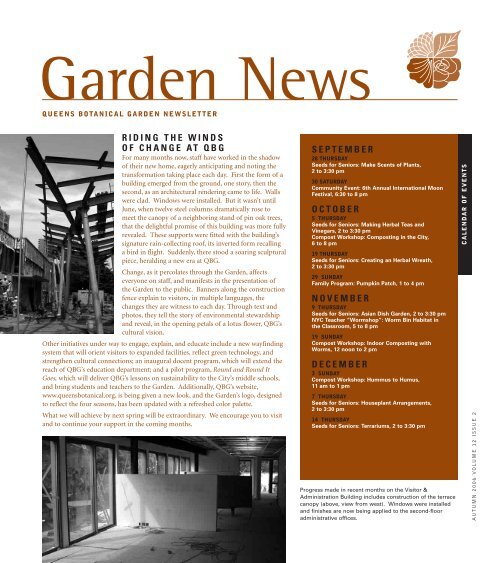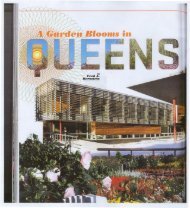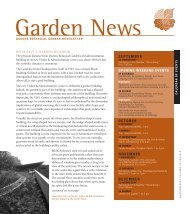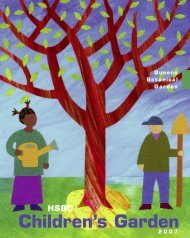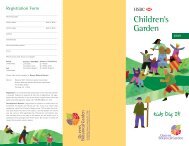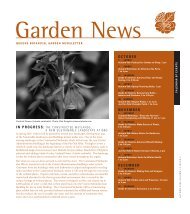Autumn Newsletter 2006 - Queens Botanical Garden
Autumn Newsletter 2006 - Queens Botanical Garden
Autumn Newsletter 2006 - Queens Botanical Garden
Create successful ePaper yourself
Turn your PDF publications into a flip-book with our unique Google optimized e-Paper software.
The <strong>Garden</strong> would like to acknowledgeand thank the following gala sponsors:Event SponsorPlaza ConstructionCorporationRed Rose SponsorsThe Bank of New YorkConsolidated EdisonCompany of New YorkCord MeyerDevelopment LLCThe DurstOrganization, Inc.Pink Rose SponsorsFlushing CommonsHSBC Bank USA, N.A.Richmond CountySavings FoundationThe Rockefeller GroupStonewallContracting Corp.TDC DevelopersWhite Rose SponsorsAlbaneseOrganization, Inc.Muss DevelopmentCompanyNew YorkHospital <strong>Queens</strong>Rotary Club of FlushingJohn B. WingateIndividual SponsorsA.T.S. MechanicalContractors, Inc.Mr. and Mrs.Richard AurelioBKSK ArchitectsCarlyle/SkylineApartmentsFarrell Fritz, PC<strong>Garden</strong> View Ltd.Graf & LewentArchitectsHan Mi RealtyHugh L. Carey BatteryPark City AuthorityKoreavillageLin + AssociatesArchitectsFrank C. MacchioGrace MengPort Authorityof NY & NJJames RisoRachel ShaT&T CommercialCapital, LLCVornado Realty TrustGOVERNMENT FUNDING UPDATEQBG is grateful to our elected officials for providingsubstantial support for the Sustainable Landscapes andBuildings Project in FY07. <strong>Queens</strong> Borough PresidentHelen Marshall has earmarked a total of $1 million incapital funding for the <strong>Garden</strong> Entrances Project in thecoming year. Mayor Michael Bloomberg has allocated$850,000 toward the completion of the Visitor &Administration Building. The New York City Councilhas committed $850,000 to the <strong>Garden</strong> Entrances Project.Last spring, the Zoos, <strong>Botanical</strong> <strong>Garden</strong>s, andAquariums Grant Program of the New York StateOffice of Parks, Recreation, and Historic Preservationawarded QBG $88,500 for collections care andinterpretation. Borough President Helen Marshallalso provided $15,000 for general operations.Executive director Sharon G. Grosser (r.) and seniorprogram officer Marian Conway (second from left), of TheRoslyn Savings Foundation, recently visited QBG and weremet by the <strong>Garden</strong>’s executive director Susan Lacerte andretired New York Community Bank vice president GeorgianaReese. Photo: Jason GreenNEW GRANTSCarnegie Corporation of New York:$100,000 award from an anonymous donor,in support of general operationsWilliam Randolph Hearst Foundations:$50,000 award in support of education programsAltman Foundation:$40,000 award for an internship coordinatorRobert Sterling Clark Foundation:$40,000 award for earned income initiativesThe Pinkerton Foundation:$25,000 award for the internship programThe Edith Glick Shoolman Children’s Foundation:$20,000 award in support of education programsLily Auchincloss Foundation:$15,000 award in support of general operationsConsolidated Edison Company of New York:$15,000 award for energy exhibit in Visitor &Administration BuildingThe Jean & Louis Dreyfus Foundation:$15,000 award for Seeds for Seniors programRichard Aurelio:$10,000 award in support of general operationsThe Max and Victoria Dreyfus Foundation:$10,000 award for the Village <strong>Garden</strong>sThe New York Community Trust:$10,000 award for earned income initiativesWalter Kaner Children’s Foundation:$6,000 award in support of special needs programsand an internAviation Development Council:$5,000 sponsorship of the Bee <strong>Garden</strong> and relatedschool programsThe Roslyn Savings Foundation:$5,000 sponsorship of the Herb <strong>Garden</strong> and relatededucation programs and horticultureSarah I. Schieffelin Residuary Trust:$5,000 award in support of general operationsSCS Astoria Energy Foundation:$5,000 award in support of general operationsPfizer Volunteer Program:$1,000 award in recognition of employeevolunteerism by Senior <strong>Garden</strong>er Joe KvietkusADOPTIONPROGRAMThe HonorableMoses Weinsteinhas adopted aCrimean linden(Tilia x euchlora)in memory ofhis wife, MurielWeinstein.The tree canbe found in theBee <strong>Garden</strong>.MEMORIAL GIFTSIn memory ofSunni Behrman:Barbara BrittonMaurice BruetPeter DunleavyFred GerberNaola B. Gersten-WoolfJames McCabeBruce McInnesKim MulcahyAndrew RabbChristopher RoddickThomas RussoNaomi ZurcherIn memory ofIna Germeck:Lois BebermanMarcia CohenLori DiamondNicole EisenhandlerMyra GeffonMarion HermanCarole LehrmanJennifer LucadamoBarbara MartinPS 144 Social ClubHarriet RabunksiHoward SternJennifer SussmanIn memory ofMary Talamo:Mary A. VavruskaIn memory ofMuriel Weinstein:Clare CooperDr. andMrs. Arthur FlugSuzanne LiChristine P’Simer<strong>Queens</strong> CountySupreme Court JusticesMr. and Mrs. RogerRosengarten10: The Terrace Canopy is completed. Its unusual shape makes an architectural statement and collects rainwaterfor recycling. 9: The sloped, concrete walls of the Auditorium are poured, using rough-cut planks as formwork to
IN MEMORIAMWith great fondness as well as sadness, we remembertwo members of QBG’s family who passed away inrecent months.A former board chair and president, Muriel M.Weinstein was a vibrant member of a core group of<strong>Garden</strong> leaders who generated support and provideddirection for the fledgling institution when it opened inits new home on Main Street in 1963. Her involvementbegan as a committeemember for theChrysanthemum Balls(the precursor to today’sRose Ball), followed bylong-standing membershipon the board of trustees,and several turns as galaMuriel Weinstein dons ahard hat for the EducationBuilding groundbreakingin 1984.co-chair and chair. Shecontinued to be a guidingforce through the mid1980s, overseeing thegroundbreaking of the Charles G. Meyer EducationBuilding in 1984, the first and only new building tobe erected at QBG until recently.Her president’s message, written that year for the 34thannual Chrysanthemum Ball, resonates today: “Forover 22 years, year after year, as season followed season,I have watched the growth of our beautiful <strong>Garden</strong>,the changing moods of our floral displays, the shiftsin terrain, the stately formal front beds, the emergingof our Backyard <strong>Garden</strong>s, the Children’s and Senior<strong>Garden</strong>s, the magnificent wonder of our Wedding<strong>Garden</strong>, and the varied herb experimental and otherventures. As our staff labored in the vineyards, as manyof our colleagues worked in our fund-raising activities,our <strong>Garden</strong> grew and grew. It is the center and the hubof many functions; yet it is still a lovely oasis of peaceand quiet in the midst of an active urban community.”QBG honored her and her husband, Judge MosesWeinstein, at the 1998 Rose Ball, which celebratedthe 50th Anniversary of the <strong>Garden</strong>’s opening.Because Rita Soares Fernandes said “yes,” more thingswere possible at QBG. A member of the Visitor Servicesstaff from 1997 to 2005, Rita welcomed thousands ofvisitors to the <strong>Garden</strong> each Sunday. She oversawweddings and receptions, photography bookings, thegarden greeters and junior weekend staff, and assistedwith public programs. The former Flushing residentgreatly enjoyed working with the public, and consideredher <strong>Garden</strong> responsibilities a perfect complement to herjob as a NYC public school teacher. Rita, who held severalmaster’s degrees, regularly imparted her love of learningto her small charges, whom she adored, and shared herenthusiasm for life and for new things with us all.INTRODUCING QBG’S GREEN TEENSIf you visited the <strong>Garden</strong> this past summer, you may have noticed a flurry of activityand enthusiasm among the staff – and many new faces! The <strong>Garden</strong>’s new internshipprogram for high school students attracted a crop of twenty-three bright and eagerteens who helped out in nearly every department. Wearing their bright greenT-shirts, they assisted youngsters in the HSBC Children’s <strong>Garden</strong>, eradicated weedsin the Cherry Circle, wrote press releases, and helped staff with projects in finance,human resources, and cultural research.The QBG High School Internship Program, renamed the QBG Green Teen Program,has finished its inaugural summer thanks to generous grants from the AltmanFoundation and The Pinkerton Foundation, as well as support from HSBC in theCommunity (USA) Inc. The <strong>Garden</strong>’s interns also received funding through LEARN,a program of the New York City Department of Education, and through TheAfterschool Corporation(TASC) and the AsociacionCultural Beneficia de FatherBillini in Corona, bothpart of the City’s SummerYouth EmploymentProgram. These grantsand partnerships enabledthe <strong>Garden</strong> to expand theinternship program beyondthe Children’s <strong>Garden</strong> to alldepartments, with weeklyworkshops to developprofessional skills and help promote “green”-collar career exploration, as well as fosterenvironmental stewardship and cultural appreciation among the teens.From an intense three-day orientation, field trips to the New York Hall of Scienceand Solar 1, and weekly meetings, this summer was a busy one for the interns, whohailed from all parts of the borough. In addition to gaining professional experience,the interns developed an array of environmental advocacy skills thatthey could bring back to their schools in September.The eight-week program culminated on August 24 with an Intern Celebration, anevent planned entirely by the teens, which helped them to develop their nonprofitevent-planning skills.The <strong>2006</strong> QBG Green TeenProgram participants were:Rabia Alam and NikkiRamroop (horticulture);Weberlange Exilus(marketing); GiovannaOrama (capital projects);Christina Cephus, AnnyCosta, Tatiana Coy, ShanteDickson, Rabiya Hass,William Jablonski, Wing YiKung, Vasantie Naraine,Arriana Prendergast, Melanie Romano, Inbar Sharon, and Maryam Wardak(Children’s <strong>Garden</strong>); Eliana Paradis (finance); Andrea Rodriguez (education); IssaDuncan and Barbara Paradis (administration); Jennifer Choi (earned income);Tiffany Cheng (cultural research); and Lisa He (compost).Jeannemarie Hendershot is QBG’s internship coordinator.give the walls a unique, visible texture. 8: Work begins on the Parking <strong>Garden</strong>, a beautiful new gateway to QBGthat also helps manage the stormwater that falls on the site. 7: The Visitor & Administration Building’s
STAFF NEWSQBG offers a warm welcome to Constance Comer,who recently joined our finance department. Conniecomes to the <strong>Garden</strong> after having worked for theUnited Nations Federal Credit Union for the past 13years. She will be responsible for preparing payroll andgeneral accounting functions including assistance withthe annual audit and budget. The balance of her timewill be with human resources.Jaymie Sharabi has joined QBG as a horticultureintern, funded in part by The Mushroom Trust andthe Stanley Smith Horticultural Trust. Jaymie, whoworked with QBG’s horticulture staff in 1999, hasgained well-rounded experience at public gardensaround NYC. In her own words: “Every early morningwhen I enter the grounds of QBG I am grateful. I havebeen given the responsibility, yes the honor, of workingand tending a piece of the Earth.”A seasonal assistant gardener, Gabriel Forestieri,joined the horticulture staff this summer. Gabriel hasextensive horticulture and gardening experience, mostrecently in California, and is also a professional dancer.After more than two decades of dedicated service to QBG,Eduardo Questell retired from the horticulture/groundsdepartment on May 1. Staff send a big thank-you toEduardo, who is enjoying retirement in Puerto Rico.<strong>Garden</strong>er Joan Boriqua earned her CommercialPesticide Technician License from the State of NewYork’s Department of Environmental Conservation.Capital Projects assistant Max Joel has been awardeda Junior Fellowship from the United Way of NYC’sNonprofit Leadership Development Institute.Max also passed his LEED Accredited Professionalexam on July 17.Following their morning exercises on July 19, members ofQBG’s Tai Chi groups delighted <strong>Garden</strong> staff and board withcontributions totaling $8,675, the result of their mostsuccessful fund-raiser to date in support of the <strong>Garden</strong>’soperations. New York City Councilmember John Liu wasamong members of the community who turned out to markthe occasion.PLANT YOUR LEGACYWHERE IT WILL . . .PRODUCEYour gift or bequest willprovide funding for the<strong>Garden</strong>’s annual programs.ENDUREYour gift or bequest willhelp the <strong>Garden</strong> meetfuture needs.To learn more about QBG’s Charitable Gift Annuityprogram and other giving opportunities, contactSusan Lacerte, executive director, at 718.886.3800,ext. 205.CORPORATEMEMBERS$15,000(a two-yearmembership)Altria Group, Inc.$5,000Goldman, Sachs& Co.NEWMEMBERS(February 9through August18, <strong>2006</strong>)Alice BodnerTzy-Ching ChuMayrdale De BorNancy FahnestockJuoy FokManitha HegdePatriciaHendershotDouglas KnightEdward andKaren MitchellScott MurphyVasanthaRamanathanCatherine ReddRosanna Roizinand JamesGrahamPenny and RobertSchnitzerVipin ThakralRamesh VeluroWilliam Martin, director ofcommunity affairs atVerizon, learns about thelatest plant mappingequipment from gardenerJoan Boriqua and culturalresearch volunteer ShelbySemmes (r.). VerizonFoundation has been alongtime supporter oftechnology initiatives atthe <strong>Garden</strong>.The arboricultural firm The Care of Trees contributed$10,000 in cash and services to QBG this past year.Welcoming president and CEO Scott Jamieson (r.) anddistrict manager Frank C. Buddingh’ to the <strong>Garden</strong> in Junewere horticulturist Marianne Kristoff, director of capitalprojects Jennifer Ward Souder, board chair Stefanie F.Handsman, and executive director Susan Lacerte.The internship was truly an experience I will never forget. All thetraining and work have done two things: help improve my workingskills and help me be a part of a beautiful living museum known asthe <strong>Queens</strong> <strong>Botanical</strong> <strong>Garden</strong>.Issa Duncan, QBG administration interngeothermal system is fully connected and tested. This system provides low energy heating and cooling and,combined with rooftop photovoltaic panels and overall efficient building design, helps the facility use over 30% less
Silverbell Halesia carolinaHalesia carolina, commonly known as silverbell, is a tree that belongs to theStyracaceae family. Found near ravines and in wooded areas, the species has a nativerange extending from Florida to West Virginia to eastern Oklahoma. Growing thirtyto forty feet tall, silverbells thrive in well-drained, moist soil. In addition, silverbellshave a high resistance to disease and are able to withstand the cold. In the fall,silverbells are one of the first trees to lose their leaves. However, this does not stopthe tree from providing a stunning display—its moderate yellow and mottledyellow-green leaves make for breathtaking foliage.EducationCHILDREN’S GARDEN <strong>2006</strong>:AN ADVENTURE THROUGH COLORThe HSBC Children’s <strong>Garden</strong> is a fun and exciting yearly adventure where childrenlearn and grow along with their plants. Each year is a fresh, innovative experience, asnew and returning friends come together to plant, in their own “private” gardens,seeds and seedlings that they nurture and watch grow into healthy flowers andvegetables and then harvest at the end of the season.During the spring session, the children prepared the garden for planting by weeding,turning the soil, and adding mulch, compost, and of course, water. They explored thegreenhouse where horticulturist Zofia Pienkos had started seeds in late winter, andhelped transplant those seedlings. They learned the fundamentals, and experiencedthe struggles, of starting and nurturing a garden.Children enrolled in the summer sessions embarked on a discovery of the colors ofthe rainbow, including our own QBG addition, brown! Each week children learnedabout important plants, vegetables, and flowers related to a particular color. Theyplanted “rainbow” vegetables that were different and exotic: Cheddar cauliflower,Purple Haze carrots, and Rainbow peppers. In addition, they created colorful herb,butterfly, and shade gardens.Many special guests joined us this year to enrich our experience. Artist AlessandraNichols from Salvage/Salvation Part IV: Hive taught us how to build nests and acompost hut from materials found in and around the <strong>Garden</strong>. From Harley Spiller,a.k.a. Inspector Collector, we learned about different insects in the garden, and howto mimic spiders by creating webs out of recycled materials. Apiarist Urte Schaedleshowed us working beehives and explained the role of honeybees in the <strong>Garden</strong>. WeHSBC senior vice president Paul Ho enjoyed meeting Children's <strong>Garden</strong> interns andparticipants on graduation day. Photo: Jason GreenBest known for their ornamental qualities, silverbells—with their delicate, bell-shaped flowers—are favoritesfor small gardens, lawns, patios, and generallandscaping. In spring, these white flowers start tobloom, attracting and providing many bees with honey.Likewise, the bark of the silverbell provides year-roundinterest with a unique display of brown, black, andgrey. Its many fine properties make the wood of thesilverbell desirable for veneer and cabinet work.Photo: Jason Greenmade a delicious salad from our own garden greens withFred Gerber, QBG director of education emeritus, whotaught us about grocery store gardening and what NativeAmericans living in our region grew and ate in the past.With Compost Project staff Victoria Gershik-Ostrovskyand Daniel Tainow we completed our rainbow learningwith lessons on compost, which has a rich brown color.Our rainbow experience culminated in tie-dyeing T-shirts on Community Day, followed by a cheerfulgraduation ceremony to celebrate the program’s end.We were fortunate to have instructor Chandani Sani,now a senior at <strong>Queens</strong> College, join us for anotheradventurous year. We were privileged to work withQBG internship coordinator Jeannemarie Hendershotand her QBG Green Teens, who assisted instructors andhelped to individualize activities.Every year I look forward to embarking upon a newvoyage as coordinator of this program, exploring lifein new and different ways and experiencing it throughthe eyes of a child. We hope that you will join us onnext year’s journey. Please call in early spring for moreinformation at 718.886.3800, ext. 230.Michele Krejci is QBG’s Children’s <strong>Garden</strong> Coordinator.QBG thanks HSBC in the Community (USA) Inc. forcontinuing its support of the Children’s <strong>Garden</strong> in <strong>2006</strong>.Plants in Community gardens (see article for more information). 5: The Cleansing Biotope and ConstructedWetlands are planted with wetland species that naturally filter and clean water. These areas cleanse rainwater
EDUCATION DEPARTMENT ANNOUNCES NEW CURRICULUMWith initial phases of QBG’s Master Plan soon to be completed, the educationstaff seized the opportunity to develop new school workshop offerings for 2007with funding provided by The Louis Calder Foundation. Guided by environmentaleducation consultant Jill Weiss, they created curriculum reflecting green technologiesshowcased in the <strong>Garden</strong>’s facilities and landscapes, deciding to focus on the primaryforces driving ecosystems that are imperative for life. The resulting first unit—Round and Round It Goes— focuses on the role of water in the environment and hasbeen designed specifically for middle-school grades six, seven, and eight.Education staff chose a multi-experiential lesson plan that includes an in-school visitby QBG staff as well as two on-site class visits to the new Visitor & AdministrationBuilding and accompanying landscapes, which are models of both natural systemsand sustainable technologies. The students learn about the water cycle and its effectson the environment, observe a wetland experiment in their own classroom, andbecome stakeholders in the <strong>Garden</strong> by planting in the constructed wetlands.The bioswales, cleansing biotopes, and constructed wetlands demonstrate how naturalsystems recycle nutrients from runoff while filtering the water, remediate and preventflooding, act as buffers to prevent soil erosion, and create habitat and nursery areasfor native species. They also serve as examples of bio-mimicry—copying nature andapplying the same principles in technology (in this case by creating ecologically soundfilters for polluted water and flood prevention measures).Plants and soil on the auditorium’s green roof absorb excess water, thus relieving ouralready overburdened combined sewage system during heavy rains. The green roofalso acts as an insulator due to the water’s high specific heat capacity (the energyrequired to raise the temperature of water or the energy given off when water cools) byabsorbing massive amounts of energy from the building in the summer and giving itoff in the winter, thus lowering our reliance on fossil fuels to heat or cool the building.The building’s geothermal heating and cooling system works on a similar principle.As QBG begins to shape a sound scientific approach to environmental studies withthis pilot program, education staff hope to inspire young minds to observe and learnfrom nature. The <strong>Garden</strong>’s systems and landscapes provide unique hands-on learningopportunities that truly solidify the student’s experience. Middle-school teachersinterested in registering for Round and Round It Goes should call the educationdepartment at 718.886.3800, ext. 230. The curriculum will also be available forviewing online at www.queensbotanical.org.QBG’S NEW DOCENTS ARE WAITING FOR YOU!Congratulations to the stellar inaugural group of QBG docents who completed severalmonths of intensive training this summer. As the <strong>Garden</strong> prepares to get the wordout to the public about its remarkable workshops and environmental stewardshipinitiatives, these individuals will be essential to communicating this information tovisitors, both young and old alike, and furthering their understanding and enjoymentof QBG’s environmental and botanical resources.Currently, docents conduct tours for school groups on a pre-scheduled basis. Thesetours are designed to enhance the workshop curriculum or emphasize a specific areaof study. Docents will soon guide special interest tours, interpret seasonal events andexhibits, and conduct hands-on family craft activities for <strong>Garden</strong> visitors. They willalso offer seasonal tours to the public on a walk-in basis. These tours will provide anoverview of several popular and significant garden exhibits and an understanding ofkey concepts related to stewardship and grounds management.QBG’s new docents are Cathy Bouchard, Frances Cleary, Milagros Dichoso, DennisGolin, Gerda Kiermeier, Irving Leos, Shirley Leos, Lola McLinden, Judith Nostramo,Gabriella Oldham, Adele Scheck, Peter Schiftan, and Yolanda Silver.CompostDear FloraQ: My worm bin has been workinggreat and the worms seem happy.However, I opened the bin the otherday and saw hundreds of littlebrownish red bugs crawling on top ofthe bedding and on the underside ofthe lid. What are these creatures?Are they a problem? And, how do Iget rid of them?~ More Than WormsA: What you have is an extreme populationof mites. Mites are an important part of thedecomposer community that you havecreated in your worm bin. They eat decayingorganic matter, fungi, and other organisms.Nevertheless, mites sometimes grow to apopulation that stresses the worms. Thisoverpopulation usually occurs in a bin thatis too wet. The worms will show their stressby refusing to eat, not coming to the surface,grouping together in a ball, failing toreproduce, or trying to escape the bin.If your large population of mites begins toproduce these behaviors from your worms,there are several things you can do to get themites back to a balanced population. First,try to lower the moisture in your bin by addingdry bedding or placing the bin outdoors in thesun and leaving the top open for a short time(make sure you don’t overheat or completelydry out your bin). Second, since thepopulation of mites is often concentratedaround a specific piece of food, you canjust remove that piece of food from the bin.If there are still too many mites after thosetreatments, you can remove the top few inchesof bedding or bait the remaining mites withsome of their favorite foods: melon wedges,raw potato slices, and moistened bread.When the mites have concentrated on the bait(sometimes on the underside), you can removethe food from the bin. Place mite-covered foodor bedding in an outdoor compost bin orgarbage can.Lastly, worm bin mites and their fellowdecomposers pose no threat to humans or livingplants. I encourage you to learn more aboutthem and appreciate the work that they do!More composting questions? E-mailcompost@queensbotanical.org or call theCompost Helpline at 718.539.LAWN(5296).and water from the Visitor & Administration Building’s drains, allowing it to be reused in the water feature andfor toilet flushing. 4: Painting is completed and furniture is moved into the new building. All interior materials and
HOW TO CREATE A “BUZZ” ABOUT COMPOSTING?Composting is not usually thought of as a “hot” topic, except in some circles likeGreen Drinks NYC (where every month people who work in the environmentalfield meet up informally for a beverage), or the Master Composter CertificationProgram (through which NYC residents of all walks of life receive training, resources,and work experience educating the public on composting). Otherwise, in the vastsphere of popular culture, outside of gardening, there is very little mention orknowledge of composting as an important part of a citizen’s responsibility inmanaging his or her garbage.As the <strong>Garden</strong>’s new Compost Project coordinator and a novice composter myself,I was curious as to why this is so. Did composting fall out of fashion? Or wascomposting always knownjust to a select few, i.e.,those who grew up onfarms or in the country?When the key words“composting” and“history” are Googled, verylittle comes up. The fewhits that do appear give uswhat I predicted: peoplereturning organics to thesoil dates back to theAkkadian Empire, 2300-2200 BC, but compostingwas fairly limited to theagricultural sphere. Not until Sir Albert Howard in the early 1900s, and later J. I.Rodale, carrying on Howard’s work from the 1940s through the early 1970s, didAmerican gardeners learn the value of composting for improving soil quality.Composting was thus expanded beyond agriculture to home gardens.Composting, now recognized as an important waste reduction method, can make theleap into everyone’s home. But what would it take to get a whole nation to compost?Legislation? Celebrity endorsements? Perhaps one or two reality show TV stars coulddemonstrate how to compost on their shows. Unless incentive programs are createdby elected officials or composting is taken up as a celebrity’s “cause,” spreading theword about composting will continue to occur at the grassroots level. While agrassroots movement can be very powerful,it requires even greater effort to engage amainstream audience.I urge you to make a commitment to startcomposting. Attend one of our upcomingworkshops. Pick up free compost at theCompost Giveback this fall. Buy a NYCsubsidized$20 compost bin to place by yourhouse. Set up a worm bin in your home.Up for more? Consider applying to the 2007Master Composter Certification Program.Victoria Gershik-Ostrovsky is QBG’s CompostProject coordinator.COMPOST PROJECT UPDATESGet free, unlimited amounts of compost from theCity at this fall’s Compost Giveback at the SpringCreek Composting Area in Brooklyn. For moreinformation, call the <strong>Queens</strong> Compost Helpline at718.539.LAWN(5296) or visit www.nyccompost.org.The Master Composter (MC) Class of <strong>2006</strong> completedthe class portion of the program and took several fieldtrips to learn about various composting systems. Tripsincluded Rikers Island Compost Facility, Red HookFarm, <strong>Garden</strong> of Union, and more. MCs are nowfulfilling their thirty-hour community servicerequirement in many ways, including walking incompost parades, tabling at events, and educatingneighbors, co-workers, and real estate agents.Applications are now being accepted for the2007 Master Composter Certification Program.Call 718.886.3800, ext. 222.Staff from Compost Projects in the five boroughs arebrainstorming on ways to collaborate and increasevisibility and interest in composting. A jointlyproduced Compost Project newsletter will be availablesoon at www.nyccompost.org. Learn about newdevelopments in composting, read accounts of theCompost Givebacks, and pick up some really neat tipsand information.“Excellent, professional, knowledgeable,kind, and courteous staff.”QBG visitor, Summer <strong>2006</strong>The Gro-Cart was on the road this summer, makingappearances at <strong>Queens</strong>’ parks, including the Hong KongDragon Boat Festival in Flushing Meadows Corona Park,where education and compost staff kept families busy withhands-on activities. QBG’s Gro-Cart is enjoying leadsupport from KeySpan Foundation in <strong>2006</strong>.finishes contain no or very low levels of harmful volatile organic compounds (VOCs), and many contain recycledmaterial. 3: QBG staff move into the new administrative offices. The old Administration Building is demolished to
<strong>Autumn</strong> Talks & WorkshopsSEEDS FOR SENIORSA <strong>Garden</strong>ing Series for Older AdultsThis fall, QBG continues to offer adults age 60 andover the opportunity to learn about gardening, sharetheir plant knowledge, and connect with nature.Seniors may sign up for one workshop per season.Pre-registration is required. Class size is limited totwenty people. Please call Marianne Giacalone,senior programs coordinator, at 718.886.3800, ext. 230.Classes meet in the <strong>Garden</strong>’s Education Building.MAKE SCENTS OF PLANTSThursday, September 28, 2 to 3:30 pmFee: $5; QBG members freeLearn why plants have an aroma as you explorevarious fragrant roots, stems, leaves, and spices.You’ll combine those you find most pleasing inan attractive sachet to bring home.MAKING HERBAL TEAS AND VINEGARSThursday, October 5, 2 to 3:30 pmFee: $5; QBG members freeChoose from a selection of dried herbs to make customherbal tea blends and herbal vinegars for home.CREATING AN HERBAL WREATHThursday, October 19, 2 to 3:30 pmFee: $5; QBG members freeLearn about the many uses of herbs and how to make anherbal wreath from the autumn garden.ASIAN DISH GARDENThursday, November 9, 2 to 3:30 pmFee: $5; QBG members freeLearn about the significance of Asian landscapesand how they differ from the history and designof Western gardens. Make a mini landscape withplants and decorations representing the principlesof an Asian garden.HOUSEPLANT ARRANGEMENTSThursday, December 7, 2 to 3:30 pmFee: $5; QBG members freeLearn how to combine plants that have similar light,water, and soil requirements. Plant your “instantgarden” in an attractive container to bring home.TERRARIUMSThursday, December 14, 2 to 3:30 pmFee: $5; QBG members freeLearn about the history and care of terrariums. Choosesuitable small houseplants and closed containers andcreate your own terrarium.Seeds for Seniors is made possible by The Jean & LouisDreyfus Foundation and is presented in collaboration withNew York Hospital <strong>Queens</strong>’ Health Outreach Program.COMPOST WORKSHOPSThese workshops are provided at no charge or for a nominal fee, thanks tofunding from the New York City Department of Sanitation. Pre-registrationis required at least one week in advance of all workshops. Call 718.886.3800,ext. 222 to register.COMPOSTING IN THE CITYThursday, October 5, 6 to 8 pmTurn city leaves, kitchen scraps, and garden trimmings into a rich, beautifulsoil conditioner through composting. Composting doesn’t take much time,work, or space. This class covers the essentials: what the composting processis, how to compost even in small city yards and apartments, how to use thefinished compost, how to avoid and solve problems, and which equipmentand tools are helpful.NYC TEACHER “WORMSHOP”:WORM BIN HABITAT IN THE CLASSROOMThursday, November 9, 5 to 8 pmFee: $10Discover the benefits of a classroom worm bin, an excellent hands-on andinquiry-based activity to teach biology, ecology, environmental science,recycling, and responsibility. Receive a refresher course on the earthwormand learn how to set up a worm bin, feed worms with food scraps, andmaintain the system effectively. Creative curriculum-related ways toincorporate worm composting into science, math, and language arts will bediscussed. Teachers will receive a bin, a voucher for a pound of worms, andthree useful texts—a value worth well over $50.INDOOR COMPOSTING WITH WORMSSunday, November 19, 12 noon to 2 pmWith the help of red wiggler worms you can recycle your kitchen scrapsand other select organic scraps into one of the richest soil amendments—vermicompost—to use on indoor and outdoor plants. Not in love withworms? We’ll teach you how to love them or how to compost indoorswithout them. Optional $10 materials fee for NYC residents provides aplastic worm bin and a voucher for a pound of red wiggler worms.HUMMUS TO HUMUSSunday, December 3, 11 am to 1 pmLearn how to make the most delicious hummus, a popular Middle Easternspread made from mashed chickpeas, tahini, lemon juice, and garlic, withthe help of Chef-Instructor Melanie Underwood of the Institute of CulinaryEducation (ICE). Afterward, discover how to turn your cooking lessonleftovers into humus, a brown or black complex material formed from partialdecomposition of plant matter. QBG’s Compost Project staff will show youhow to responsibly compost these kitchenscraps.For information on free compost givebacksand compost bin sales, as well as answers tocompost and lawn care questions, check outwww.nyccompost.org or call the <strong>Queens</strong> CompostHelpline at 718.539.LAWN(5296).COMPOST WORKSHOPSmake way for a new Entry Plaza and water feature. 2: The Entry Plaza Fountain is turned on and recycledrainwater flows through its channel across the Plaza, alongside the Visitor & Administration Building, and back
Special Events6TH ANNUALINTERNATIONALMOON FESTIVALA Community Celebration!Saturday, September 30, 6:30 to 8 pmFreeJoin us for an evening of traditional music, story,and song celebrating the autumn equinox and theharvest. Festivities get under way at 6 pm in downtownFlushing at 39th Avenue, with a colorful parade downMain Street to QBG. Bring a blanket or a chair and afriend. Organized by the Flushing Development Center.PUMPKIN PATCHSunday, October 29, drop in from 1 to 4 pmFee: $5 per child (includes pumpkin and activities)The Children’s <strong>Garden</strong> becomes a spooky pumpkin patch, with Count Dracula and otherwhimsical characters on hand to entertain families while kids paint their pumpkins andcreate a Green-Haired Monster to take home. Halloween treats are included.This year’s Pumpkin Patch also includes a special Compost Project Show-and-Tell.(What did the pumpkin say to the Wicked Witch when it was put into a compost bin?“I’m melting!”) Starting at 1 pm, come enjoy our show-and-tell featuring trick-ortreatpumpkin worm bins, both real and plastic. At 2 pm, Compost Dan shares hispicture gallery of a composting pumpkin, and at 3 pm you’ll be treated to a reading ofJackie-O’s Great Adventure. Afterward, treats will be handed out to all good listeners.WHY NOT BECOME A MEMBER TODAY?■ Individual Member $35■ Individual Senior $30■ Dual $50■ Dual Senior $45■ Family $60■ Supporting Member $100■ Friend $250■ Patron $500■ Life Member $5,000■ Organization $150■ Please call me about the Planned GivingProgram■ My check is enclosed, made payable to:<strong>Queens</strong> <strong>Botanical</strong> <strong>Garden</strong>, 43-50 Main Street,Flushing, New York 11355, 718.886.3800Here’s a sampling of what you’ll find blooming at QBG this fall.LATE SEPTEMBER:<strong>Autumn</strong> clematis, asters, chrysanthemums, chelone,sedum, caryopteris, tricytrisOCTOBER:Roses, franklinia, chrysanthemums, dahlias, anemone, asters,sedum, hydrangea, solidago, witch hazelNOVEMBER:Ornamental grass, flowering cabbage and kaleDECEMBER:Berries on holly, skimmia, cotoneaster, and dogwood; pine cones onconifers; Christmas roseCRAFT SALESRenowned for their exquisite artistry, members of QBG’s Craft Group designfloral creations for all occasions. Fragrant dried flower arrangements makethoughtful holiday, wedding, and house-warming gifts, while pressed flowerart frames beautifully display birth announcements, wedding invitations, andphotos. Visit their workshop in the Plant Shop trailer, on Tuesdays andThursdays, from 9:30 am to 12:30 pm, by appointment. Call 718.886.3800,ext. 200, for more information.BLOOM CALENDARNAMEADDRESSCITY/STATE/ZIPTELEPHONEE-MAILTo learn about the benefits of membership,visit www.queensbotanical.org or call718.886.3800, ext. 213.The <strong>Queens</strong> <strong>Botanical</strong> <strong>Garden</strong>, an independent not-for-profitinstitution located on City-owned land, is governed by avolunteer board of trustees. It is partially supported bypublic funds through the New York City Department ofCultural Affairs; the Zoos, <strong>Botanical</strong> <strong>Garden</strong>s, and AquariumsGrant Program of the New York State Office of Parks,Recreation, and Historic Preservation; <strong>Queens</strong> BoroughPresident Helen Marshall; the New York City Council; StateSenator Frank Padavan; State Senator Serphin R. Maltese;and the New York State Assembly <strong>Queens</strong> Delegation. TheNew York City Department of Sanitation provides funding forQBG’s Compost Project. Additional support through privatesources includes contributions from corporations,foundations, and individuals.Lead support for the Gro-Carthas been provided byPrinted with soy-basedinks on New Leaf 100%post-consumer waste fiberpaper, processed withoutthe use of chlorine orchlorine derivatives.Forest StewardshipCouncil certified.to the Cleansing Biotope. 1: New informational kiosks and signposts are installed throughout the <strong>Garden</strong> to help visitorsfind their way around and learn about QBG. Grand Opening in Spring 2007!
Nonprofit Org.U.S. Postage PaidPermit #433Flushing NYPhoto: Jason GreenPUMPKIN PATCHSunday, October 29, 1 to 4 pm<strong>Garden</strong> Offices and Visitor Information718.886.3800<strong>Autumn</strong> Hours (Through October)Tuesday through Friday, 8 am to 6 pmSaturday and Sunday, 8 am to 7 pmWinter Hours (November through March)Tuesday through Sunday, 8 am to 4:30 pmClosed Mondays year-roundexcept legal holidaysAdmissionFree. Donations welcomed.Parking$5; $3 members (depending on level of support)Days and hours vary by season.Plant InformationTuesday and Friday, 9 am to 4 pm, ext. 200Compost Information718.539.LAWN(5296) or compost@queensbotanical.orgQBG Websitewww.queensbotanical.orgGetting HereQBG is easily accessible by car, train, or bus.For complete travel directions and furtherinformation, phone QBG or visit us online.GENERAL INFORMATION


